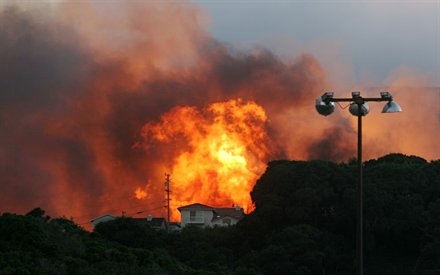 Fire burning through a San Bruno neighborhood.Veronica WeberAn explosion from a ruptured natural-gas line killed at least four people and destroyed an entire city block in the San Francisco suburb of San Bruno on Thursday night.
Fire burning through a San Bruno neighborhood.Veronica WeberAn explosion from a ruptured natural-gas line killed at least four people and destroyed an entire city block in the San Francisco suburb of San Bruno on Thursday night.
Also on Thursday, a pipeline burst in a Romeoville, Ill., industrial park and is still spewing oil. It’s from same Canadian oil company that spilled more than 800,000 gallons of tar sands crude oil into a Michigan creek this summer.
And of course the slow cleanup from the BP rig blowout continues in the Gulf of Mexico. That mishap, in turn, overshadowed the Massey Energy coal-mine explosion that killed 29 workers, and the coal freighter that crashed into the Great Barrier Reef on a shortcut back to China earlier this year.
The costs of these disasters — human, ecological, and economic — are clear enough. And the costs are still sky-high when these projects go right — when coal, oil, and gas are safely extracted and burned and their heat-trapping pollutants sent into the atmosphere (as The Onion described so well).
But harping and nagging and saying “See how bad fossil fuels are” doesn’t really get us anywhere.
Here’s why: People already know that our dependence on dirty energy is a problem. They get it. There’s even an appetite for a national clean-energy strategy/program — it’s just not overwhelming enough to overcome the undemocratic dynamics of the Senate.
So why aren’t we sufficiently riled up to change the situation? One of the more persuasive theories is status quo bias. Psychologists find that when people are anxious (and nothing breeds anxiety like a recession), they cling to what they know, even if it’s clearly problematic. Our fossil-fuel economy may be gasping, sputtering, and occasionally blowing up homes, but at least it’s the devil we know, not some mysterious cleantech network of solar panels and smart meters and compact neighborhoods.
People don’t need hectoring told-you-so’s. They need to see a vision of a sustainable future that actually looks appealing.
I grabbed a beer with Greenpeace USA Executive Director Phil Radford a few weeks ago, and he asked me what I’d do if I ran Greenpeace for a week. I offered the idea of an un-protest — a twist on the group’s classic strategy of staging high-visibility protests at sites where environmental damage is being done. Why not instead ambush places that are doing things right — say, Ohio’s Oberlin College, Sweden’s Hammarby Sjostad neighborhood, or the car-free Times Square (for better visibility)? Hang banners and find a way to make a ruckus, in celebration rather than protest. Radford was amused — we’ll see if Greenpeace runs with it.
We’ve got plenty of examples of the disasters we’re trying to avoid; compelling examples of what we’re working for are harder to come by.


